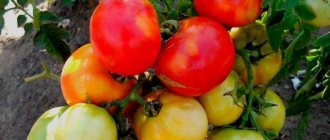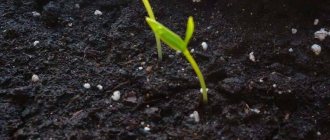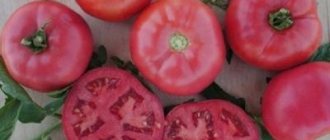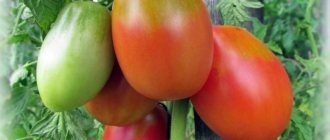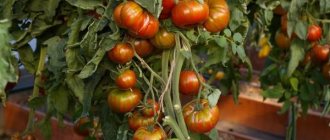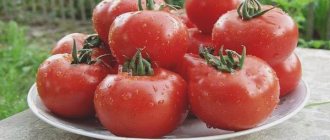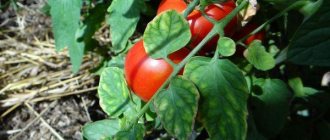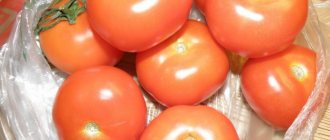History of origin
Tomato Lezhebok was created on the basis of Gavrish LLC in 1998. The target direction of hybridization is to obtain early-ripening tomatoes with a long shelf life. Experimental cultivation confirmed all the characteristics declared by the originator, and in 2002 the hybrid Lezhebok was added to the State Register list.
Approved for cultivation in open ground in the Southern regions, in the Central and Middle zones - in film tunnels and cold closed structures, in the North-Eastern regions - in heated greenhouses.
Lazybok – variety of Tomato plant
Variety characteristics:
Properties of the Lezhebok variety:
Recommended region on the map:
Information on the admission of Tomato Lezhebok from the Register of the State Variety Commission of the Russian Federation
Application for admission No. 35701, registered 2001-02-09. The Tomato variety Lezhebok was included in the register of approved varieties in 2002. Approved for use in regions: All regions.
The originator of the Tomato Lezhebok variety is:
Other varieties of tomato plant
Search for variety by name
Variety selection
Description of the tomato variety Lezhebok
An open bush of determinant, non-standard type, generative type of growth. The priority in the growing season is the ripening of fruits, not the growth of the crown. The tomato is formed with two stems, the height of which does not exceed 130 cm.
Description of the Lezhebok variety:
- The supporting shoots are not thick, rigid, and, due to their length, require fixation to the trellis. The surface is slightly ribbed, light green, pubescent.
- The side shoots are few and grow slowly.
- The leaves are elongated, with carved edges, dark green, trilobed.
- The flowers are small, yellow, each producing a viable ovary. The Lazhebok tomato is self-pollinating, the yield of marketable products is 98%.
- Fruit clusters are simple. Density – 4-5 tomatoes. The lower brush is formed from the sixth leaf axil, the subsequent ones - from every second. There are 4-5 of them on the stem.
- The tomatoes are flat-round, weighing 120-140 g.
- The surface is smooth, the peel is red, with a glossy sheen. The pulp is dense, with two seed chambers. Unripe tomatoes have white, hard segments.
Important!
The Lazhebok hybrid is not propagated by self-collected seeds. Plants of the second generation do not retain varietal characteristics. The taste of tomatoes is sweet and sour, the aroma is not pronounced.
The fruit clusters are heavy; tying to the stem is recommended
Description
Characteristics of the Lezhebok tomato: mid-season variety, medium-leafed bush, 1–1.2 m high, grown in two stems. Bushes with intermediate inflorescence. The yield of the variety is quite high: 4–5 kg of net harvest comes out from one root.
The fruit is round, slightly flattened. One tomato has an average weight of 120 - 140 grams. Due to the absence of excess juice, the fruits are dense, fleshy, and remain fresh until winter. As is typical for hybrids, they have an excellent sweet and sour taste. The skin is smooth, bright red.
Tomatoes can easily withstand transportation without losing their taste or presentation. Can be stored in a cool, dry place until the New Year holidays.
Characteristics of tomato Lazybok
The hybrid is early, from the moment of germination to the removal of the first fruits, 110 days pass. The Lezhebok variety is harvested in July. Fruiting is not extended, the tomatoes of the lower and last clusters ripen at the same time. If the tomatoes remain at the stage of technical ripeness, after unloading the bush, 7-12 days are enough for them to fully ripen.
Productivity of tomato Lazybok
Forming a bush with three or more stems to increase the yield is not justified, since there will be more tomatoes, but their mass will be less. The yield will be the same as that of a Lazybok tomato with two shoots, but normal fruit weight. 5-5.5 kg are collected from one plant. It is not recommended to place more than three tomatoes per 1 m2. Ideally, two seedlings. The fruiting rate per 1 m² ranges from 12-15 kg.
Resistance to diseases and pests
The couch potato, like all hybrid forms of culture, is highly resistant to damage by pathogenic microorganisms. Tomato is not afraid of the following infections:
- fusarium wilt;
- late blight;
- Phomasis;
- leaf mold;
- brown spot;
- top and root rot.
If the watering regime is not followed while growing seedlings, the tomato Lezhebok may become infected with black leg.
The Colorado potato beetle, aphids, slugs, and whiteflies do not harm the crop.
In heated greenhouses with high air humidity and dense planting, the Lazhebok tomato is parasitized by spider mites.
Application area
The harvested crop can be used for all types of processing, except for obtaining juice. The hybrid is not productive in this regard. The Lazhebok tomato is used to make paste and puree, but is more often used for whole-fruit canning or cold pickling. The main purpose of the fruit is to eat fresh in salads or in regular cuts. Tomatoes are also quite suitable for culinary recipes.
Planting and care
You can choose any container for sowing seedlings. Particular preference is given to plastic containers with single cups: in the future you will not have to pick young tomatoes and disturb the root system.
After sowing tomato seeds, it is necessary to water and feed the seedlings in a timely manner. When the first full leaves of a tomato appear, the container with tomatoes must be evenly turned towards the sun every 2 days, otherwise the bushes will grow one-sided.
Advantages and disadvantages
The Lezhebok tomato is grown in private plots and in the fields of agricultural complexes. In the latter case, the purpose is commercial. The hybrid can be transported over fairly long distances without losing its presentation.
Tomatoes of the Lezhebok variety picked in July at a temperature of +40 C do not lose their nutritional value until November
Pros:
- early amicable maturation;
- high productivity;
- long shelf life;
- possibility of cultivation in all regions;
- suitable for open ground and greenhouses;
- standard agricultural technology;
- immunity to infections and pests;
- versatility in use;
- does not crack and does not bake in the sun.
Minuses:
- unexpressed aroma;
- during long-term storage, voids form in the pulp;
- the possibility of seed germination in the whole tomato;
- does not provide adequate material for reproduction.
Attention! The hybrid Lazhebok requires pruning of the lower leaves, removal of stepsons and gartering not only of the stems, but also of the brushes.
Seed preparation
Sowing tomatoes for seedlings begins in late March - early April. To achieve a rich harvest, you need not only high-quality seeds, but also certain skills and knowledge. Before sowing, seeds must be disinfected.
Visually, it is almost impossible to distinguish diseased tomato seeds from healthy ones. It would be safer to first disinfect the seed material. There are several ways to destroy pests located inside and on the surface of seeds:
- Dry method. Place tomato seed material in the sun for several days - when heated under the sun's rays, the seeds will be disinfected and will germinate faster.
- Wet method. For half a liter of warm water, 1 teaspoon of potassium permanganate. Place tomato seeds in the solution and leave for half an hour at room temperature. Then rinse thoroughly and dry.
See also
Characteristics and description of the tomato variety Legend Tarasenko (multiflora), its yieldRead
Features of cultivation
Seeds are purchased from the retail chain. Original material is sold only. Preliminary sorting and disinfection are not necessary; the Lezhebok tomato is processed before packaging. The early variety is grown by seedlings. To obtain planting material, laying the seeds of the Lezhebok tomato is carried out at the end of March:
- Fill the containers with a mixture of compost and peat; you can purchase a ready-made substrate.
- Water with a hot solution of manganese and leave for a day.
- Longitudinal grooves are made on the surface, the tomato is distributed at intervals of 1 cm. Cover with soil and water with any growth stimulant.
- Cover the containers and maintain the temperature at +22-25 0C.
- After the sprouts appear, remove the covering structure and increase daylight hours to 16 hours.
- As the top layer of the substrate dries, water it with an aerosol method.
- After the formation of three leaves, the seedlings are planted in separate containers.
The Lazhebok tomato is planted at the age of 60 days.
They are placed in an open bed approximately in May. You can go to the greenhouse earlier:
- The area under the tomatoes is dug up, roots and remaining vegetation are removed, and compost is added.
- Plant the Lazybok tomato at intervals of 50–60 cm in furrows or trenches.
- The depth of the planting place is to the lower leaves, the width is to completely distribute the root along the bottom.
- The seedlings are covered with soil and watered abundantly with Energen.
When the tomato rises to 20 cm, they hill it up and cover it with a layer of humus mulch.
Agricultural technology of the hybrid Lezhebok:
- Watering in greenhouses twice every 10 days (20 liters of water to the root). In an open area, they are guided by precipitation so that the soil does not dry out, but there is also no stagnation of moisture.
- The tree trunk circle is loosened to prevent compaction. Remove weeds.
- Tomatoes are fed with nitrogen before flowering, and with phosphorus during the formation of ovaries. After 15 days they give potassium, after two weeks - superphosphate. The application of liquid organic matter is combined with watering.
The stems are tied up, excess leaves are removed and planted.
Details and features of agricultural technology, reviews of the hybrid
Tomato Lozhebok F1 needs to be planted as seedlings. The optimal time is between March and April. By the end of May or the beginning of June, the sprouts will be ready to move to a permanent place: to the greenhouse - earlier, to open ground - later. For 1 sq. m area place 4 plants. Scheme 40x50 cm. 4-5 days after transplantation, make the first garter of the rooted bush.
Advice. It is recommended to plant in 2-3 stems.
Gardeners actively comment on the properties and other features of tomatoes and leave reviews about them on the Internet. Summer resident Elena tested the hybrid on her plot in the Leningrad region. She did not specify how exactly she planted the crop. The tomato turned out to be productive, but the taste turned out to be ordinary. The woman used the entire harvest for winter storage.
Mafi (Ekaterinburg) described her experience in greenhouse cultivation of a hybrid:
- the bushes were smooth and strong (up to 1.5 m);
- there were few stepsons;
- each plant bore 5 clusters (5-7 fruits each), after which the bush stopped growing;
- The tomatoes grew almost identical in size and shape and ripened at the same time.
Despite all the positive aspects, the taste disappointed the gardener. And during storage (mid-October), the seeds inside the fruits began to germinate.
Tomato Lezhebok F1 has long been known to gardeners. People have disagreements about taste. Many people grow the hybrid because of the long shelf life of the crop.
Pest and disease control methods
For preventive purposes, at the beginning of the growing season, tomatoes are treated in a permanent place with preparations containing copper.
Important! In closed structures, waterlogging of the air and soil is avoided. Plants are placed so as to avoid crowded planting.
These measures are enough to prevent tomatoes from getting sick.
When growing seedlings, do not allow low temperatures and stagnation of water in the container. If the conditions are not met, the seedlings are affected by blackleg. It will not be possible to save a diseased plant; such material is discarded.
The lesion is identified by a dark area in the area of the root collar; rotting quickly spreads to the stem and causes the death of the plant
The spider mite that parasitizes the Lazhebok tomato is destroyed at the first sign of appearance using the drug “Iskra Bio”
A sucking microscopic insect weaves a web around the main location
